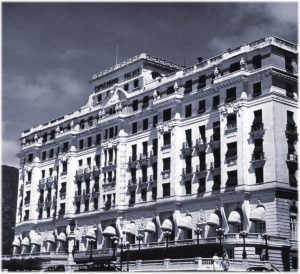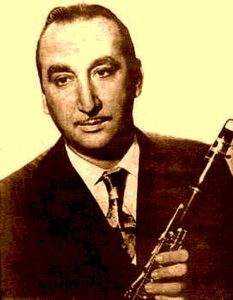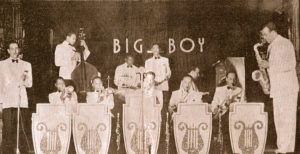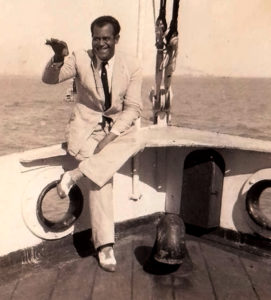Friend of the Ray Ventura Orchestra, 1941-44
South America had a tiny enclave of European entertainers seeking refuge from the European war. “Big Boy” encountered a number of his former associates, becoming friendly with cats from the Ray Ventura Orchestra. Singer and successful bandleader Ray Ventura (1908-1979) led a very popular French dance and Swing orchestra in the 1930s. Ventura was Jewish and brought most of his musicians to Brazil in 1941.
In the pensao photo above is Henri Salvador (1917-2008) — a Caribbean-born singer, comedian, guitarist and trumpet player who was associated with Ventura. Their bassist, Louis Vola (1902-1988) was a founding member of Django Reinhardt’s Quintet of the Hot Club of France, heard on about 200 of their recordings and was on some of the records Goudie made with the Willie Lewis orchestra a few years earlier.
In mid-1942 Ventura took his band to Argentina. Their 1944 return to Rio was when Frank played with the orchestra. But they soon disbanded and Ray went back to Europe.
“Playing Brazilian Music Has Helped Me A Lot”
To be sure, most of the music Goudie played in Brazil and South America was NOT Jazz or Swing. He worked with bands specializing primarily in samba, conga, rhumba, carioca and other indigenous dance music. On the southern continent a hybrid samba-swing style developed fusing the big band format with deeply syncopated Latin rhythms and popular song in Portuguese or Spanish.
During the latter half of his residence in Rio Frank worked for the most successful and popular impressario of the samba-swing ensembles, Aristide Zaccarias (1911-2000). Performing at the Copacabana Palace Hotel, its well-drilled powerful horn section of five reeds and five brasses was formidable.
Zaccarias led on alto sax and clarinet. They toured widely and recorded for RCA, waxing some of the biggest hits of Brazilian music. It’s believed that Goudie made records in Rio, and though there’s no proof that he recorded with Zaccarias it is strongly suspected.
Aristide Zaccarias e su Orchestra, 1943-45:
Tico Tico no Fuba
Cai, Cai
O Caminho e Longo Para Tipperary (It’s a Long Way to Tipperary)
Zaccarias, Hadlock and Big Boy
In his teens, Richard Hadlock’s father worked for RCA Victor in Rio de Janeiro. Teen-aged Hadlock took alto saxophone lessons from Zaccarias c. 1943-44. “Not much of a jazz man it turns out,” he says, recalling that the bandleader lacked a feeling for jazz. Richard reports that “Zac,” as he called him was, “a masterful saxophone player so he wanted the saxes to be GOOD and wrote tough parts for them — and for himself.”
At the time Richard noted the towering African American multi-instrumentalist reed player in the orchestra. Today he suggests that because Zaccarias was star alto saxophonist, solos for Goudie on tenor were probably rare; he was likely confined to section work.
Though too shy to introduce himself, Richard took note of Goudie’s “very French restaurant just around the corner” from the family apartment. Hadlock never ate there. But walking by often, he glanced in the front window observing, “four or five tables with red-checked tablecloths just like a Parisian movie set.” Adding, “Goudie always had something going.”
Hadlock recalls Zaccarias and Goudie in Rio.mp3
Big Boy’s Jazz in Rio
By the early 1940s Rio de Janeiro was a sophisticated cosmopolitan center of finance, industry and culture where Swing and Jazz had begun to find acceptance. A native jazz movement started taking shape encouraged by “Big Boy.”
Goudie was popular enough by 1941 to attempt recreating his Parisian world. “Big Jazz, led by Big Boy, the famous saxophonist,” was reported drawing a social elite to Rio’s Teatro Municipal theater grill, a sumptuous Babylonian-styled restaurant.
Hiring local musicians, he launched Big Boy and his Golden Boys. It was a group functioning like his former Little Boys back in Paris — a jazz and dance band run on the side while he worked for big-name bandleaders. More like a small orchestra, the Golden Boys utilized up to eleven instruments and a singer, but was also available as a combo. Goudie led and arranged the four-saxophone front line.
Presented as a world-class attraction, the Golden Boys’ broad repertoire encompassed sambas, congas, boleros and choros, yet also included waltzes, blues, marches and fox trots. All the personnel besides Frank appear to have been Brazilians.
Reports of a Goudie combo at the Copacabana Casino in July 1944 inform us he was playing sax and sometimes trumpet. When “Big Boy” took a solo, the writer said he had to stop dancing and listen to his hefty, energetic playing. In late 1945 Goudie was at one of the best jazz clubs in Rio – Avenida — playing with a band offering mostly Brazilian music, but also swing renditions of “Louise” and “Sugar Blues.”
Bringing Hot Jazz to Brazil
Frank lent his talents and endorsement to the fledgling Hot Club of Brazil in September 1945. He performed as a draw for their inaugural events – as he had for the fledgling Parisian Hot Clubs in France a decade earlier.
At a concert where Goudie was the main attraction reported Diario Carioca, “the hall went wild” at a, “terrific party that went on till dawn.” The same month another publication, Cena Muda, reported on a Grand Jam Session hosted by the Hot Club declaring him “among the best jazz tenors in South America.”
While Frank assessed Brazil “a country without Swing” as one writer paraphrased him, he departed the southern hemisphere on a high note richer for the experience. Two decades later he told Richard Hadlock in an interview, “It took a couple of years to really learn the samba rhythms, but it was worth it. Playing Brazilian music has helped me a lot.”
Return to Paris and Disque Swing, 1946-47
The Goudies landed back in France on August 1, 1946. Madeleine – organized and enterprising – settled into running a book and stationary shop. Frank promptly resumed making records for the Disque Swing label.
Jazz and blues authority Jacques Morgantini who interviewed him around this time declared, “He . . . played some splendid blues on clarinet. He was a gentle, calm man, very affable. Charming actually.”
This was his most intense period of commercial recording. Goudie waxed more than two-dozen titles for the French jazz label — several under his own name. He was on a couple of the label’s jam session discs.
It’s clear that Frank’s saxophone technique had expanded; now encompassing the tenor style of Lester Young. “Big Boy” was featured in a trio with blues and boogie-woogie piano player Charlie “Dizzy” Lewis — who had been in France since the 1920s. The double-sided “St. Louis Blues” (unissued for decades) demonstrates that he’d developed a distinct talent for extended clarinet blues improvisations.
Big Boy Trio, 1946-47:
Blue Drag
Big Boy Boogie
St. Louis Blues (Pts. 1 & 2)
“Big Boy” was increasingly employed filling the growing demand for West Indian and Caribbean music. He worked in the ensembles of trumpet player Harry Cooper, Los Criollos Orchestra (The Creoles) and others.
But now in his late forties Frank was feeling burned-out and listless. He complained to friends about his asthma and poor digestion, which he attributed to the climate and canned food of South America. He’d quit playing trumpet for health reasons and stopped drinking on account of his liver.
- ← Previous page
- (Page 2 of 3)
- Next page →





For further exploration:
Frank Goudie page:
http://www.jazzhotbigstep.com/120601.html
Bill Coleman page:
http://www.jazzhotbigstep.com/121401.html
BIG BOY Book:
http://www.jazzedit.org/English/EBb/Big-Boy.html
Frank Goudie on i-tunes:
https://itunes.apple.com/us/album/frank-big-boy-goudie-on-west-coast-vol-1-big-boys-blues/1345446943
Great series Dave. Thanks!